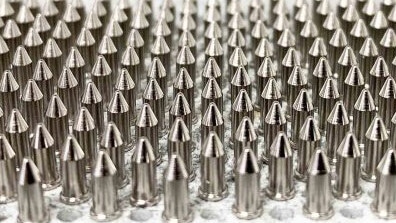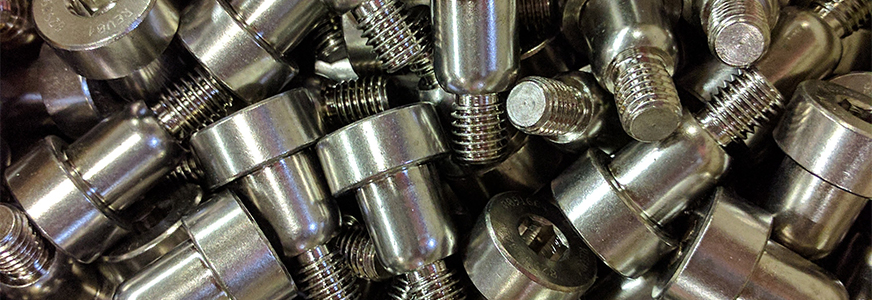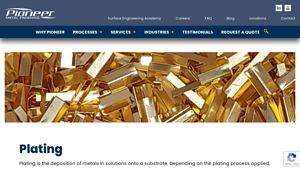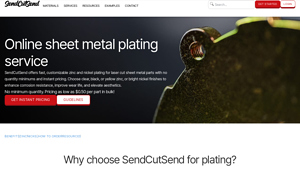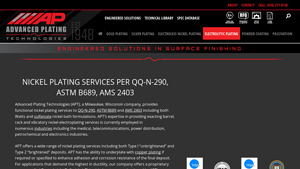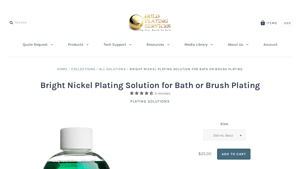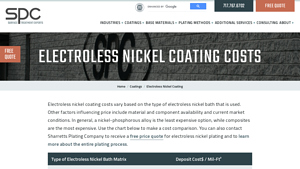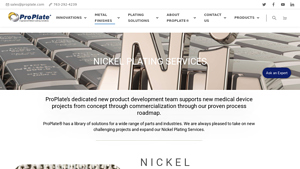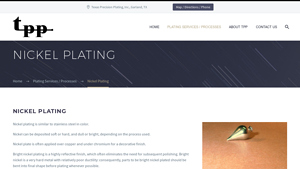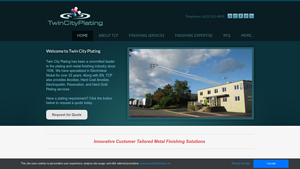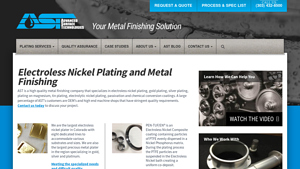Nickel Plating Service Guide: Type, Cost, Top List…
Introduction: Navigating the Global Market for nickel plating service
Navigating the complexities of sourcing nickel plating services can pose significant challenges for international B2B buyers, particularly in regions like Africa, South America, the Middle East, and Europe. With varying quality standards, compliance regulations, and market dynamics, making informed decisions becomes crucial. This guide serves as a comprehensive resource, exploring the diverse types of nickel plating available—ranging from electrolytic to electroless nickel plating—and their specific applications across industries.
In addition to detailing the performance benefits and specifications associated with each plating type, this guide emphasizes the importance of supplier vetting processes. Buyers will gain insights into evaluating potential suppliers based on quality certifications, environmental compliance, and production capabilities. Understanding the cost structures and factors influencing pricing will also be covered, equipping buyers with the knowledge to negotiate effectively and secure the best value for their investments.
By providing actionable insights and a structured approach to sourcing nickel plating services, this guide empowers B2B buyers to navigate the global market confidently. Whether you are in Nigeria, Brazil, or any other region, you will find the tools necessary to enhance your procurement strategy and foster successful partnerships in the nickel plating industry.
Understanding nickel plating service Types and Variations
| Type Name | Key Distinguishing Features | Primary B2B Applications | Brief Pros & Cons for Buyers |
|---|---|---|---|
| Electrolytic Nickel | Deposits nickel through an electrolytic process; offers good corrosion resistance and a decorative finish. | Automotive, electronics, and decorative applications. | Pros: Good corrosion protection, versatile; Cons: Surface may require additional finishing. |
| Electroless Nickel | Autocatalytic process providing uniform coating; excellent wear resistance and corrosion protection. | Aerospace, oil and gas, and manufacturing. | Pros: Uniform thickness, no post-processing needed; Cons: Higher cost compared to electrolytic. |
| Nickel Sulfamate | Produces a highly ductile, low-stress coating; typically has a matte finish. | Electronics, aerospace components, and as an undercoat. | Pros: Excellent solderability and ductility; Cons: Limited aesthetic appeal due to matte finish. |
| Black Nickel | Electrolytic nickel with a secondary treatment for a black finish; maintains conductivity. | Electronics, decorative applications, and automotive parts. | Pros: Low reflectivity, good corrosion resistance; Cons: Color may fade over time. |
| Bright Nickel | Provides a shiny finish; primarily used for aesthetic purposes while offering corrosion resistance. | Consumer goods, electronics, and decorative items. | Pros: Attractive appearance, good corrosion resistance; Cons: Can show scratches easily. |
What Are the Characteristics of Electrolytic Nickel Plating?
Electrolytic nickel plating involves depositing nickel onto a substrate using an electrolytic solution. This method is widely favored in industries such as automotive and electronics due to its effective corrosion resistance and ability to provide a decorative finish. B2B buyers should consider the potential need for additional surface finishing, as the quality of the electrolytic nickel layer can vary based on the substrate and process parameters.
How Does Electroless Nickel Plating Differ from Other Types?
Electroless nickel plating is unique as it does not require an electric current; instead, it relies on a chemical reaction to deposit nickel uniformly on the substrate. This method is particularly suitable for complex geometries and components requiring exceptional wear and corrosion resistance, making it ideal for aerospace and oil and gas applications. Buyers should weigh the higher costs against the benefits of uniform coating and elimination of post-processing.
What Makes Nickel Sulfamate a Preferred Choice for Certain Applications?
Nickel sulfamate plating is characterized by its highly ductile and low-stress coating, often resulting in a matte finish. This type is commonly used in electronics and aerospace, especially as an undercoat to enhance subsequent plating processes. B2B buyers should consider its excellent solderability and ductility, though the aesthetic appeal may be a drawback for applications requiring a polished look.
What Are the Advantages of Black Nickel Plating?
Black nickel plating involves an electrolytic nickel process followed by a treatment that gives a black finish. This type is popular in electronics and automotive parts due to its low reflectivity and good corrosion resistance. However, buyers should be aware that while it offers an attractive appearance, the color may fade over time, potentially impacting the longevity of the aesthetic quality.
Why Choose Bright Nickel Plating for Decorative Applications?
Bright nickel plating is primarily used for its aesthetic qualities, providing a shiny, appealing finish while also offering corrosion resistance. This type is often found in consumer goods and decorative items. While it enhances product appearance, buyers should note that bright nickel can scratch easily, which may affect the long-term visual appeal of the finished product.
Key Industrial Applications of nickel plating service
| Industry/Sector | Specific Application of nickel plating service | Value/Benefit for the Business | Key Sourcing Considerations for this Application |
|---|---|---|---|
| Automotive | Engine components and fasteners | Enhanced corrosion resistance and wear life | Compliance with automotive industry standards and specifications |
| Electronics | Connectors and circuit boards | Improved conductivity and solderability | Compatibility with RoHS and REACH regulations |
| Aerospace | Aircraft components and assemblies | Weight reduction and increased durability | Certification to aerospace quality standards (e.g., AS9100) |
| Oil & Gas | Valves and pumps | Resistance to harsh environments and corrosion | Ability to handle high-pressure and temperature conditions |
| Medical Devices | Surgical instruments and implants | Biocompatibility and corrosion resistance | Compliance with FDA regulations and ISO standards |
How is Nickel Plating Used in the Automotive Sector?
In the automotive industry, nickel plating is extensively used on engine components and fasteners to enhance their durability. The process provides a protective layer that resists corrosion and wear, which is critical in high-performance applications. Buyers in this sector should ensure that the plating meets specific automotive standards and can withstand extreme conditions, including exposure to chemicals and temperature fluctuations, particularly in regions like Africa and South America where environmental factors can vary greatly.
What Role Does Nickel Plating Play in Electronics?
Nickel plating is vital in the electronics sector, particularly for connectors and circuit boards. It enhances electrical conductivity and solderability, ensuring reliable connections in devices. B2B buyers must consider compliance with international regulations such as RoHS and REACH to ensure that their products are safe and environmentally friendly. Suppliers should also provide detailed specifications to guarantee compatibility with various electronic components.
How is Nickel Plating Beneficial in Aerospace Applications?
In aerospace, nickel plating is applied to aircraft components and assemblies to reduce weight while increasing durability. This application is crucial for enhancing the lifespan of parts subjected to extreme conditions. Buyers must seek suppliers that comply with aerospace quality standards, such as AS9100, to ensure that the plating meets rigorous performance and safety requirements, particularly in the Middle East and Europe where aerospace regulations are stringent.
Why is Nickel Plating Important for Oil & Gas Equipment?
Nickel plating is essential for valves and pumps used in the oil and gas industry, providing resistance to corrosion and wear in harsh environments. This application is particularly beneficial for equipment operating under high pressure and temperature conditions. Buyers should prioritize sourcing from manufacturers experienced in oil and gas applications, ensuring that the plating can withstand the specific challenges faced in this industry, especially in regions with demanding operational conditions.
How Does Nickel Plating Enhance Medical Devices?
In the medical field, nickel plating is used on surgical instruments and implants to provide biocompatibility and corrosion resistance. This is crucial for ensuring the safety and longevity of medical devices. Buyers in this sector must ensure that their suppliers comply with FDA regulations and ISO standards to guarantee the quality and safety of plated components, particularly in markets like Brazil and Nigeria where regulatory compliance is critical for successful product approval.
3 Common User Pain Points for ‘nickel plating service’ & Their Solutions
Scenario 1: Inconsistent Quality of Nickel Plating Finishes
The Problem: B2B buyers often face significant challenges related to the consistency and quality of nickel plating finishes. This inconsistency can manifest in various ways, such as uneven thickness, poor adhesion, or visible imperfections that compromise the aesthetic and functional properties of the plated parts. For manufacturers in industries such as automotive or electronics, where precision and reliability are paramount, these issues can lead to costly rework, delays in production, and a tarnished reputation among clients. Buyers may also struggle to find suppliers who can consistently meet their specifications, leading to frustration and uncertainty in their supply chain.
The Solution: To mitigate quality issues, B2B buyers should take a proactive approach in selecting and collaborating with nickel plating service providers. First, it is crucial to establish clear specifications that outline the desired thickness, appearance, and performance characteristics of the nickel plating. Buyers should request samples or conduct pilot runs to assess the quality before committing to larger orders. Additionally, engaging with suppliers who implement robust quality control measures—such as adherence to industry standards (e.g., ASTM, SAE) and regular audits of their plating processes—can significantly enhance consistency. Building a long-term relationship with a trusted supplier who understands your unique needs can also foster better communication and lead to improved outcomes over time.
Scenario 2: Delays in Production Due to Long Lead Times
The Problem: Long lead times for nickel plating services can severely impact production schedules, particularly for manufacturers who rely on just-in-time inventory systems. B2B buyers may find themselves in a bind when their projects are delayed due to slow turnaround times from plating suppliers. This situation can create a domino effect, delaying product launches, increasing operational costs, and potentially leading to lost sales opportunities. Buyers, especially in regions like Africa or South America where supply chains may already be stretched, need to ensure that their plating partners can deliver promptly.
The Solution: To avoid production delays, buyers should prioritize working with plating service providers that offer transparent lead times and reliable delivery schedules. When sourcing suppliers, inquire about their capacity to handle urgent orders and their typical processing times for various plating services. It can be beneficial to establish a buffer stock of plated components for high-demand periods, thus allowing for flexibility in meeting customer demands without facing delays. Additionally, consider leveraging technology such as online platforms that provide instant quotes and allow for real-time tracking of orders. This approach not only streamlines the ordering process but also helps buyers stay informed about their order status, reducing uncertainty and enhancing operational efficiency.
Scenario 3: Difficulty in Understanding Nickel Plating Options and Specifications
The Problem: Many B2B buyers encounter confusion when navigating the various nickel plating options available, each with distinct specifications and applications. The terms surrounding different plating methods, such as electrolytic versus electroless nickel plating, can be overwhelming, especially for those new to the industry. This lack of understanding can lead to selecting the wrong type of plating for specific applications, resulting in suboptimal performance, increased costs, and wasted resources.
The Solution: To empower buyers in making informed decisions, it is essential to invest time in education about the different nickel plating processes and their respective benefits. Buyers should consider collaborating with knowledgeable suppliers who can provide comprehensive guidance on the various options available. Request detailed information on the technical specifications, applications, and performance characteristics of each plating type. Additionally, attending industry seminars, webinars, or workshops can deepen understanding and help buyers stay abreast of advancements in plating technologies. By fostering a strong partnership with suppliers and staying informed, buyers can confidently choose the right nickel plating service that aligns with their operational needs and product requirements.
Strategic Material Selection Guide for nickel plating service
What Are the Key Materials Used for Nickel Plating Services?
Nickel plating is a versatile process used to enhance the properties of various substrates. Understanding the materials that are commonly plated with nickel can help international B2B buyers make informed decisions based on performance, cost, and application requirements.
1. Stainless Steel
Key Properties:
Stainless steel is known for its excellent corrosion resistance and high-temperature tolerance. It typically withstands temperatures up to 800°C and has a good pressure rating, making it suitable for various industrial applications.
Pros & Cons:
The primary advantage of nickel plating on stainless steel is the enhanced corrosion resistance and aesthetic appeal. However, the cost of stainless steel can be higher than other materials, and its machining complexity can add to manufacturing costs.
Impact on Application:
Nickel-plated stainless steel is ideal for applications in the food processing, medical, and automotive industries, where hygiene and durability are paramount. Its compatibility with various media, including acids and alkalis, enhances its utility.
Considerations for International Buyers:
Buyers should ensure compliance with standards such as ASTM A240 for stainless steel and ASTM B689 for nickel plating. In regions like Europe and the Middle East, adherence to RoHS and REACH regulations is also crucial.
2. Copper
Key Properties:
Copper offers excellent electrical conductivity and thermal properties, making it a preferred choice for electrical components. It has a relatively low melting point (1,984°F or 1,085°C) and is highly ductile.
Pros & Cons:
The advantage of nickel plating on copper is the significant improvement in corrosion resistance and solderability. However, copper is prone to oxidation, which can affect its performance if not properly plated. The cost of copper can vary based on market fluctuations.
Impact on Application:
Nickel-plated copper is widely used in electronics, telecommunications, and connectors due to its conductivity. It is particularly effective in applications requiring electromagnetic shielding.
Considerations for International Buyers:
Buyers should be aware of the ASTM B733 standard for nickel plating on copper. Compliance with environmental regulations is also essential, especially in regions like Africa and South America, where local standards may differ.
3. Aluminum Alloys
Key Properties:
Aluminum alloys are lightweight with good corrosion resistance and thermal conductivity. They can typically handle temperatures up to 600°F (316°C) and are often used in aerospace and automotive applications.
Pros & Cons:
Nickel plating enhances the wear resistance and aesthetic qualities of aluminum alloys. However, the plating process can be more complex due to aluminum’s tendency to form an oxide layer, which may require additional pre-treatment steps.
Impact on Application:
Nickel-plated aluminum is ideal for applications in the aerospace, automotive, and marine industries, where weight savings and corrosion resistance are critical.
Considerations for International Buyers:
Compliance with standards such as ASTM B733 for aluminum is important. Buyers in Europe should also consider the implications of the EU’s ELV directive, which affects the use of certain materials in vehicles.
4. Brass
Key Properties:
Brass, an alloy of copper and zinc, is known for its good corrosion resistance and machinability. It is also relatively cost-effective and can withstand moderate temperatures.
Pros & Cons:
Nickel plating on brass improves its corrosion resistance and aesthetic appeal. However, brass can be less durable than stainless steel or aluminum, which may limit its use in high-stress applications.
Impact on Application:
Nickel-plated brass is commonly used in plumbing fittings, electrical connectors, and decorative applications. Its compatibility with various media makes it versatile.
Considerations for International Buyers:
Buyers should ensure compliance with ASTM B579 for brass plating. Understanding local regulations regarding lead content in brass is also crucial, especially in regions like Africa and South America.
Summary Table of Material Selection for Nickel Plating Service
| Material | Typical Use Case for nickel plating service | Key Advantage | Key Disadvantage/Limitation | Relative Cost (Low/Med/High) |
|---|---|---|---|---|
| Stainless Steel | Food processing, medical equipment | Excellent corrosion resistance | Higher cost and machining complexity | High |
| Copper | Electronics, telecommunications | Superior conductivity | Prone to oxidation without proper plating | Medium |
| Aluminum Alloys | Aerospace, automotive components | Lightweight with good corrosion resistance | Complex plating process due to oxidation | Medium |
| Brass | Plumbing fittings, decorative applications | Cost-effective with good machinability | Less durable than other materials | Low |
This guide provides a comprehensive overview of common materials used in nickel plating services, assisting international B2B buyers in making informed decisions tailored to their specific industry needs.
In-depth Look: Manufacturing Processes and Quality Assurance for nickel plating service
What Are the Key Stages in the Nickel Plating Manufacturing Process?
The nickel plating manufacturing process is a multi-stage operation designed to ensure the optimal performance and quality of the plated parts. Understanding this process is crucial for B2B buyers seeking reliable suppliers, particularly in regions like Africa, South America, the Middle East, and Europe.
Material Preparation: How Is the Substrate Prepared for Nickel Plating?
The first step in nickel plating is material preparation, which involves cleaning the substrate to remove any contaminants that could affect adhesion and quality. This cleaning process typically includes:
- Degreasing: The substrate is treated with solvents or alkaline solutions to remove oils and grease.
- Acid Cleaning: A mild acid solution is used to eliminate oxides and scale from the surface, ensuring a clean substrate.
- Rinsing: After cleaning, the parts are thoroughly rinsed to remove any residual cleaning agents.
Proper material preparation is critical as it directly influences the bond strength between the nickel layer and the substrate, thereby enhancing corrosion resistance and overall durability.
What Techniques Are Commonly Used in Nickel Plating?
Once the substrate is prepared, various plating techniques can be employed. The choice of technique often depends on the intended application and specific material characteristics.
Electrolytic Nickel Plating: What Is It and How Does It Work?
Electrolytic nickel plating is the most common method, where nickel ions are deposited onto the substrate from an electrolyte solution through the application of an electric current. Key aspects include:
- Bath Composition: The electrolyte typically contains nickel sulfate, nickel chloride, and boric acid, which influences the quality and properties of the plated surface.
- Current Density Control: Adjusting the current density can impact the thickness and quality of the nickel layer, making it crucial for achieving desired specifications.
Electroless Nickel Plating: What Are Its Advantages?
Electroless nickel plating is another widely used technique that involves a chemical reaction to deposit nickel without the need for electrical current. This method provides several benefits:
- Uniform Coverage: Electroless plating ensures consistent thickness over complex geometries, which is particularly beneficial for intricate parts.
- Excellent Corrosion Resistance: The nickel-phosphorus alloy formed during the process enhances corrosion resistance and wear characteristics.
How Is Quality Assurance Implemented in Nickel Plating Services?
Quality assurance (QA) is a vital aspect of the nickel plating process, ensuring that the final product meets international standards and customer expectations.
What International Standards Are Relevant for Nickel Plating Quality?
B2B buyers should be aware of various international standards that govern nickel plating processes:
- ISO 9001: This standard focuses on quality management systems, ensuring that suppliers maintain consistent quality in their operations.
- RoHS Compliance: Particularly important in Europe, this directive restricts hazardous substances in electrical and electronic equipment, ensuring that plated components are safe for use.
What QC Checkpoints Are Important During the Nickel Plating Process?
Quality control checkpoints are integral to maintaining high standards throughout the manufacturing process. Common checkpoints include:
- Incoming Quality Control (IQC): Verification of raw materials to ensure they meet specified standards before processing.
- In-Process Quality Control (IPQC): Monitoring plating conditions, such as temperature and current density, to ensure optimal plating quality during production.
- Final Quality Control (FQC): Comprehensive inspection of finished products to ensure they meet dimensional and surface quality specifications.
What Testing Methods Are Commonly Used for Nickel Plating Quality Assurance?
Several testing methods can be employed to evaluate the quality of nickel plating, including:
- Thickness Measurement: Utilizing tools such as X-ray fluorescence (XRF) to measure the thickness of the nickel layer, ensuring it meets specified requirements.
- Adhesion Testing: Conducting tests to determine the bond strength between the nickel coating and the substrate, often using tape tests or scratch tests.
- Corrosion Testing: Subjecting plated parts to accelerated corrosion tests, such as salt spray tests, to assess their resistance to environmental factors.
How Can B2B Buyers Verify Supplier Quality Control Processes?
For B2B buyers, especially those in emerging markets, verifying the quality control processes of potential suppliers is crucial. Here are some strategies:
- Supplier Audits: Conducting on-site audits to assess the manufacturing processes and quality control measures in place.
- Quality Reports: Requesting detailed quality reports that document testing results and compliance with industry standards.
- Third-Party Inspections: Engaging third-party inspection services can provide an unbiased assessment of the supplier’s quality practices.
What Are the QC and Certification Nuances for International B2B Buyers?
International buyers must navigate various certification requirements that may differ by region. For example, while RoHS compliance is critical in Europe, other markets may have unique regulations. Understanding these nuances is essential for ensuring compliance and avoiding potential legal issues.
Furthermore, buyers should consider the supplier’s ability to accommodate specific regional requirements, such as certification for local markets in Africa or South America. Establishing clear communication regarding quality expectations and compliance can help mitigate risks and enhance collaboration.
Conclusion: The Importance of Manufacturing Processes and Quality Assurance in Nickel Plating
Understanding the intricacies of manufacturing processes and quality assurance in nickel plating is crucial for B2B buyers. By focusing on material preparation, techniques used, quality control checkpoints, and testing methods, buyers can make informed decisions when selecting suppliers. Additionally, verifying quality control processes and understanding regional certification nuances can significantly impact the success of international partnerships.
Practical Sourcing Guide: A Step-by-Step Checklist for ‘nickel plating service’
When sourcing nickel plating services, it is essential to follow a systematic approach to ensure you select a reliable and high-quality supplier. This guide outlines a step-by-step checklist designed to help international B2B buyers effectively navigate the procurement process.
Step 1: Define Your Technical Specifications
Clearly outlining your technical requirements is fundamental to finding a suitable nickel plating service. Consider factors such as the type of nickel plating (electrolytic vs. electroless), the desired thickness, and the substrate materials you will be using. Having precise specifications helps suppliers provide accurate quotes and ensures that the final product meets your performance criteria.
- Substrate Types: Common metals include aluminum alloys, stainless steel, brass, and copper.
- Thickness Requirements: Specify the thickness range, typically between 0.0001″ to 0.005″.
Step 2: Research Potential Suppliers
Conduct thorough research to identify potential suppliers who specialize in nickel plating services. Look for companies with a strong reputation in the industry and positive customer reviews. Utilize online platforms, trade shows, and industry directories to compile a list of candidates.
- Check Online Reviews: Websites like Trustpilot and industry-specific forums can provide insights into supplier reliability.
- Industry Experience: Prioritize suppliers with experience in your specific industry, as they will better understand your requirements.
Step 3: Evaluate Supplier Certifications
Before proceeding, verify that potential suppliers hold the necessary certifications and adhere to relevant industry standards. Certifications like ISO 9001 or compliance with RoHS and REACH regulations indicate a commitment to quality and environmental responsibility.
- Quality Control Processes: Inquire about their quality assurance measures and any testing protocols they follow.
- Environmental Compliance: Ensure that the supplier follows eco-friendly practices in their plating processes.
Step 4: Request Samples and Case Studies
To assess the quality of a supplier’s work, request samples of their nickel plating or case studies from previous projects. This step is vital for evaluating their capabilities and understanding how they handle specific requirements.
- Sample Evaluation: Look for uniformity, adherence, and finish quality in the samples.
- Relevant Case Studies: Focus on projects similar to yours to gauge their experience and expertise.
Step 5: Discuss Pricing and Terms
Once you have shortlisted potential suppliers, engage in discussions about pricing, minimum order quantities, and payment terms. Understanding the cost structure will help you budget effectively and avoid unexpected expenses.
- Bulk Pricing: Inquire about discounts for larger orders to optimize your procurement costs.
- Lead Times: Clarify production timelines to ensure they align with your project schedule.
Step 6: Assess Customer Support and Communication
Effective communication is crucial throughout the sourcing process. Evaluate how responsive and helpful suppliers are during your initial inquiries. A supplier that prioritizes customer service will be easier to work with and more likely to address any issues that arise.
- Response Time: Measure how quickly they answer queries and provide information.
- Support Availability: Ensure they offer support throughout the project lifecycle, from order placement to delivery.
Step 7: Finalize Contracts and Agreements
After selecting a supplier, ensure that all terms are clearly documented in a contract. This contract should outline pricing, delivery schedules, quality expectations, and any warranties or guarantees.
- Legal Review: Consider having legal counsel review the contract to protect your interests.
- Performance Metrics: Establish clear performance metrics to evaluate the supplier’s adherence to agreed standards.
By following this checklist, B2B buyers can confidently navigate the sourcing process for nickel plating services, ensuring they select a supplier that meets their technical needs and business goals.
Comprehensive Cost and Pricing Analysis for nickel plating service Sourcing
What Are the Key Cost Components of Nickel Plating Services?
When sourcing nickel plating services, understanding the cost structure is essential for effective budgeting and negotiation. The primary cost components include:
-
Materials: The quality of nickel used for plating significantly influences pricing. High-purity electrolytic nickel, for instance, tends to be more expensive than less refined alternatives. The type of substrate also impacts material costs, as certain metals require more preparation and treatment.
-
Labor: Skilled labor is necessary for the plating process, which can vary by region. Labor costs may be higher in developed countries due to stricter labor laws and wage standards. Conversely, sourcing from regions with lower labor costs can provide savings, but it may come with trade-offs in quality and consistency.
-
Manufacturing Overhead: This encompasses the costs related to the operation of the plating facility, including utilities, maintenance, and equipment depreciation. Overhead can be a hidden cost, so it’s crucial to factor this into total pricing.
-
Tooling: Specific tooling may be required for custom parts or unique plating processes, which can add to initial costs. Depending on the complexity and volume of orders, these costs may be amortized over time.
-
Quality Control (QC): Rigorous QC measures are vital in ensuring the integrity of plated products. This includes inspections and tests that comply with industry standards, which can increase costs but are essential for maintaining quality assurance.
-
Logistics: Transporting raw materials and finished products can incur significant costs, especially for international shipping. Factors such as distance, freight methods, and customs duties play a critical role in the logistics component of pricing.
-
Margin: Finally, suppliers will add a profit margin to the total cost of production. This margin can vary based on competition, market demand, and the perceived value of the service provided.
How Do Price Influencers Affect Nickel Plating Costs?
Several factors can influence the pricing of nickel plating services:
-
Volume and Minimum Order Quantity (MOQ): Bulk orders typically lead to lower per-unit costs. Suppliers often have minimum order quantities, which can affect pricing strategies for smaller businesses.
-
Specifications and Customization: Custom specifications, such as thickness and finish type, can increase costs. Standardized products tend to be less expensive due to streamlined processes.
-
Materials and Quality Certifications: The choice of materials and any required certifications (e.g., RoHS, REACH) can impact pricing. High-quality materials and compliance with international standards often lead to higher costs but ensure better performance and reliability.
-
Supplier Factors: The supplier’s location, reputation, and production capabilities can greatly affect pricing. Established suppliers with advanced technology may charge more but offer superior quality and reliability.
-
Incoterms: Understanding shipping terms can help buyers manage costs effectively. Terms like FOB (Free on Board) or CIF (Cost, Insurance, and Freight) can influence the total landed cost.
What Are Some Negotiation Tips for International B2B Buyers?
For international buyers, particularly from regions such as Africa, South America, the Middle East, and Europe, there are several strategies to enhance cost efficiency:
-
Leverage Volume Discounts: Consider consolidating orders to meet MOQ requirements, which can lead to significant savings.
-
Assess Total Cost of Ownership (TCO): Beyond initial pricing, evaluate factors such as maintenance, durability, and logistics to determine the long-term value of the plating service.
-
Negotiate Terms: Don’t hesitate to negotiate payment terms, delivery schedules, and pricing based on market conditions and competitor offerings.
-
Understand Pricing Nuances: Be aware of how local market dynamics, currency fluctuations, and trade agreements may influence pricing.
-
Build Relationships: Establishing a strong relationship with suppliers can lead to better pricing and service, as they may prioritize repeat customers.
Disclaimer on Pricing
Pricing for nickel plating services can vary widely based on the factors mentioned above. The indicative prices provided by suppliers are subject to change based on market conditions and specific project requirements. Always request detailed quotes that reflect the unique needs of your business to ensure transparency and accuracy in budgeting.
Alternatives Analysis: Comparing nickel plating service With Other Solutions
When evaluating surface treatment options, businesses often seek alternatives to nickel plating services that can provide similar benefits such as corrosion resistance, wear protection, and aesthetic appeal. Understanding these alternatives helps B2B buyers make informed decisions tailored to their specific applications and requirements. Below is a comparative analysis of nickel plating against two viable alternatives: zinc plating and electroless nickel plating.
| Comparison Aspect | Nickel Plating Service | Zinc Plating | Electroless Nickel Plating |
|---|---|---|---|
| Performance | Excellent corrosion resistance; good wear resistance; decorative finish. | Good corrosion resistance; provides a sacrificial layer. | Superior wear resistance; uniform coating on complex geometries. |
| Cost | Moderate to high, depending on thickness and substrate. | Generally low; cost-effective for bulk applications. | Moderate; higher than zinc but competitive with nickel plating. |
| Ease of Implementation | Requires specialized equipment and expertise; more complex. | Simple and widely available; suitable for high-volume applications. | Requires precise control over process parameters; more complex than zinc. |
| Maintenance | Low maintenance; durable finish but may require touch-ups. | Moderate; sacrificial nature means it can degrade over time. | Low maintenance; long-lasting with minimal wear. |
| Best Use Case | Applications requiring high corrosion resistance and aesthetics, such as automotive parts. | Cost-sensitive applications needing basic corrosion protection, like fasteners. | Applications needing uniform coating on complex shapes, such as electronics. |
What Are the Pros and Cons of Zinc Plating as an Alternative to Nickel Plating?
Zinc plating is often chosen for its cost-effectiveness and simplicity. It provides a good level of corrosion resistance, especially in applications where a sacrificial layer is beneficial. However, zinc plating may not offer the same aesthetic appeal or durability as nickel plating. It is best suited for fasteners and components that require basic protection without the need for a decorative finish. Additionally, the sacrificial nature of zinc means that while it protects the underlying metal initially, it will degrade over time, necessitating periodic replacement.
How Does Electroless Nickel Plating Compare to Nickel Plating?
Electroless nickel plating is a notable alternative due to its uniform coating capabilities, which are particularly advantageous for complex geometries where traditional plating may leave areas uncoated. It offers excellent wear resistance and corrosion protection comparable to nickel plating. However, the process requires precise control over conditions, which can complicate implementation. This method is typically more expensive than zinc plating but may be more cost-effective than nickel plating in certain applications, particularly in the electronics sector where uniformity is critical.
Conclusion: How Should B2B Buyers Choose the Right Plating Solution?
Choosing the right plating solution involves evaluating specific project requirements, including performance needs, budget constraints, and production capabilities. For applications demanding high corrosion resistance and aesthetic qualities, nickel plating remains a strong contender. However, for cost-sensitive projects, zinc plating may be more appropriate, while electroless nickel plating offers unique advantages for complex shapes and uniformity. B2B buyers should carefully assess these factors to select the most suitable plating option that aligns with their operational and product goals.
Essential Technical Properties and Trade Terminology for nickel plating service
What Are the Key Technical Properties of Nickel Plating Services?
Understanding the essential technical properties of nickel plating is crucial for B2B buyers seeking high-quality surface treatments. Here are some critical specifications to consider:
1. Material Grade
Nickel plating can be applied using different grades of nickel, primarily categorized into electrolytic nickel and electroless nickel. The choice of material grade affects the performance characteristics, such as ductility and corrosion resistance. Buyers should specify the appropriate grade based on the application requirements to ensure optimal performance.
2. Plating Thickness
The thickness of nickel plating typically ranges from 0.00005 to 0.005 inches (50 to 5000 microinches). This specification is vital as it directly influences the coating’s durability and performance in applications such as corrosion resistance and wear protection. For example, thicker coatings may provide better wear resistance but could also lead to dimensional changes that affect component fit.
3. Receptive Metals
Nickel plating is compatible with various substrates, including aluminum alloys, stainless steel, brass, and copper. Understanding which materials can accept nickel plating is essential for ensuring a successful adhesion and performance of the plating. Buyers should communicate the substrate material when requesting quotes to avoid compatibility issues.
4. Standard Specifications
Compliance with industry standards such as AMS-QQ-N-290 (for electrolytic nickel) or ASTM B689 (for nickel sulfamate) ensures that the plating meets specific performance criteria. These standards help buyers assess the quality and reliability of the nickel plating service, ensuring it aligns with their operational needs.
5. Corrosion Resistance
Nickel plating provides significant corrosion protection, making it an ideal choice for components exposed to harsh environments. The level of corrosion resistance can vary based on the plating method and thickness, impacting the longevity of the part. Buyers should evaluate the environmental conditions their products will face to choose an appropriate nickel plating solution.
6. Ductility and Stress Levels
Electroless nickel plating offers high ductility and low internal stress, making it suitable for applications requiring intricate geometries. Understanding these properties helps buyers select a plating process that minimizes the risk of cracking or peeling, especially in precision components.
What Are Common Trade Terms in Nickel Plating Services?
Familiarity with industry jargon is essential for effective communication and negotiation in the nickel plating sector. Here are some common terms that B2B buyers should know:
1. OEM (Original Equipment Manufacturer)
An OEM refers to a company that produces parts or equipment that may be marketed by another manufacturer. Understanding the OEM status of a supplier can help buyers assess the quality and reliability of the plating service they are considering.
2. MOQ (Minimum Order Quantity)
MOQ is the smallest quantity of a product that a supplier is willing to sell. Knowing the MOQ is crucial for buyers to determine if a supplier’s offering aligns with their project needs, especially for smaller businesses or one-off projects.
3. RFQ (Request for Quotation)
An RFQ is a document sent to suppliers to request pricing and terms for specific products or services. Including detailed specifications in an RFQ ensures that buyers receive accurate quotes and helps in comparing multiple suppliers effectively.
4. Incoterms (International Commercial Terms)
Incoterms are a set of predefined commercial terms used in international trade to clarify the responsibilities of buyers and sellers. Understanding these terms is vital for B2B transactions, as they define who pays for shipping, insurance, and tariffs, impacting the total cost of nickel plating services.
5. Lead Time
Lead time refers to the amount of time it takes from placing an order until the product is delivered. It is a critical factor for B2B buyers to consider when planning production schedules and inventory management.
6. Coating Uniformity
This term describes the consistency of the plating thickness across the surface of the part. Ensuring good coating uniformity is essential for achieving reliable performance in applications, making it a key specification for buyers when selecting a plating service.
By grasping these technical properties and trade terms, B2B buyers can make informed decisions when sourcing nickel plating services, ensuring they select the right suppliers for their specific needs.
Navigating Market Dynamics and Sourcing Trends in the nickel plating service Sector
What Are the Key Trends Shaping the Nickel Plating Service Market?
The nickel plating service market is experiencing significant growth driven by several global factors. The increasing demand for corrosion-resistant and durable materials across various industries, such as automotive, aerospace, electronics, and manufacturing, is a primary driver. As businesses focus on enhancing product longevity and performance, nickel plating offers a reliable solution, providing excellent corrosion resistance, wear resistance, and aesthetic appeal.
Emerging B2B technologies are transforming sourcing practices within this sector. For instance, advancements in automation and digital platforms facilitate instant pricing and order management, allowing buyers to streamline procurement processes. Companies like SendCutSend are leveraging online platforms to offer customizable nickel plating solutions with no minimum order quantities, appealing to both small and large manufacturers. Moreover, the rise of Industry 4.0 technologies, such as IoT and AI, is enhancing quality control and monitoring capabilities, ensuring consistent product standards.
Geographically, international buyers from regions like Africa, South America, the Middle East, and Europe are increasingly sourcing nickel plating services to meet local and global standards. The demand in these regions is also influenced by local regulations and compliance requirements, such as RoHS and REACH, which necessitate adherence to environmental and safety standards. As a result, buyers must be vigilant in evaluating suppliers based on their compliance certifications and capabilities to ensure they meet market expectations.
How Is Sustainability Impacting Nickel Plating Services and Sourcing Decisions?
Sustainability is becoming a crucial consideration for B2B buyers in the nickel plating service sector. The environmental impact of plating processes, particularly concerning wastewater management and chemical usage, has prompted companies to seek environmentally responsible suppliers. The industry is witnessing a shift towards “green” plating processes that minimize harmful emissions and waste. Innovations such as eco-friendly nickel plating solutions and closed-loop water recycling systems are gaining traction.
Moreover, ethical sourcing is increasingly relevant for businesses aiming to enhance their corporate social responsibility (CSR) profiles. Buyers are prioritizing suppliers who demonstrate a commitment to ethical practices, including fair labor standards and responsible sourcing of raw materials. Certifications such as ISO 14001 for environmental management and adherence to the UN’s Sustainable Development Goals (SDGs) are becoming key criteria for supplier selection.
Incorporating sustainable practices not only mitigates environmental impact but can also yield economic benefits, such as reduced material costs and enhanced brand reputation. As the global market evolves, buyers are encouraged to engage with suppliers who prioritize sustainability and transparency in their operations, ensuring that their sourcing decisions align with their corporate values and market expectations.
What Is the Historical Context of Nickel Plating Services?
Nickel plating has a rich history that dates back to the early 19th century when it was first introduced as a decorative finish. Over the decades, the process evolved significantly, transitioning from manual techniques to modern electroplating methods. The introduction of electrolytic nickel plating in the early 20th century revolutionized the industry by offering superior adhesion and uniformity, making it a preferred choice for various applications.
As technology advanced, the use of nickel plating expanded beyond aesthetics to functional applications, particularly in industries requiring corrosion resistance and electrical conductivity. Today, nickel plating services are integral to many sectors, including automotive and electronics, where performance and durability are paramount. The ongoing evolution of this service continues to shape procurement strategies and sourcing trends, making it essential for buyers to stay informed about advancements in techniques and compliance standards.
Frequently Asked Questions (FAQs) for B2B Buyers of nickel plating service
-
How do I choose the right nickel plating service for my business needs?
Selecting the right nickel plating service involves evaluating several factors. First, consider the specific requirements of your project, such as the type of nickel plating (electrolytic, electroless, etc.), thickness, and finish. Next, assess the supplier’s certifications and compliance with international standards like RoHS and REACH. Additionally, review their quality control processes, turnaround times, and past client testimonials. Finally, request samples or trial runs to evaluate the quality before committing to larger orders. -
What is the typical lead time for nickel plating services?
Lead times for nickel plating services can vary significantly based on the supplier, project complexity, and order volume. Typically, standard orders may take anywhere from 1 to 4 weeks. However, larger or more intricate projects may require additional time. It’s advisable to communicate your timeline during the initial inquiry and request an estimated delivery date. For urgent projects, some suppliers offer expedited services at an additional cost. -
What are the minimum order quantities (MOQs) for nickel plating services?
Minimum order quantities (MOQs) can differ among suppliers and are often influenced by the specific plating process and materials used. Some companies may have no minimums, especially for custom projects, while others may require a MOQ to justify production costs. When sourcing a nickel plating service, inquire about MOQs to ensure they align with your project needs, especially if you are testing a new product or market. -
How can I ensure the quality of the nickel plating service I choose?
To ensure high-quality nickel plating, start by selecting suppliers with relevant industry certifications, such as ISO 9001. Ask about their quality control measures, including pre- and post-plating inspections. Request documentation of previous work, including test results for adhesion, thickness, and corrosion resistance. It’s also beneficial to read reviews and testimonials from other clients to gauge their satisfaction with the service provided. -
What payment terms are typically offered by nickel plating service providers?
Payment terms can vary based on the supplier and the scale of your order. Common arrangements include upfront payment, net 30 days, or even payment upon delivery. Some suppliers may offer discounts for early payment or bulk orders. When negotiating terms, consider your cash flow and financial planning, and ensure that the agreement is documented clearly in the contract to avoid misunderstandings. -
What materials can be plated with nickel, and how does this affect the process?
Nickel plating can be applied to a variety of metals, including steel, brass, copper, and aluminum. The choice of substrate material affects the plating process, as different metals require specific pre-treatment and plating conditions. For instance, copper may need to be pre-plated with a layer of nickel to enhance adhesion. Ensure your supplier is experienced with your chosen material to achieve optimal results. -
What logistics considerations should I keep in mind when sourcing nickel plating services internationally?
When sourcing nickel plating services internationally, consider shipping costs, customs regulations, and potential tariffs. It’s essential to work with suppliers who have experience handling international shipments and understand the logistics of cross-border trade. Discuss delivery timelines and ensure your chosen service can accommodate your project schedule. Additionally, consider insurance for high-value shipments to protect against loss or damage during transit. -
Can I customize the nickel plating finish for my specific applications?
Yes, many nickel plating service providers offer customization options to meet specific application requirements. You can request variations in thickness, finish (e.g., bright or matte), and even color. Discuss your project needs with potential suppliers, and inquire about their ability to accommodate custom specifications. Providing detailed drawings or prototypes can help ensure that the final product aligns with your expectations.
Important Disclaimer & Terms of Use
⚠️ Important Disclaimer
The information provided in this guide, including content regarding manufacturers, technical specifications, and market analysis, is for informational and educational purposes only. It does not constitute professional procurement advice, financial advice, or legal advice.
While we have made every effort to ensure the accuracy and timeliness of the information, we are not responsible for any errors, omissions, or outdated information. Market conditions, company details, and technical standards are subject to change.
B2B buyers must conduct their own independent and thorough due diligence before making any purchasing decisions. This includes contacting suppliers directly, verifying certifications, requesting samples, and seeking professional consultation. The risk of relying on any information in this guide is borne solely by the reader.
Top 9 Nickel Plating Service Manufacturers & Suppliers List
1. Pioneer Metal – Black Nickel Plating
Domain: pioneermetal.com
Registered: 1997 (28 years)
Introduction: {‘plating_services’: [{‘name’: ‘Black Nickel’, ‘description’: ‘Electrolytic nickel plating with a secondary treatment to turn the surface black.’, ‘benefits’: [‘Low Reflectivity’, ‘Corrosion Resistance’, ‘Good Conductivity’], ‘receptive_metals’: [‘Aluminum Alloy’, ‘Aluminum Casting’, ‘Stainless Steel’, ‘Brass’, ‘Steel’, ‘Copper’, ‘Bronze’], ‘thickness’: ‘.0001-.005″‘, ‘max_part_size’: ’27” x 18″ x…
2. SendCutSend – Custom Zinc and Nickel Plating
Domain: sendcutsend.com
Registered: 2015 (10 years)
Introduction: SendCutSend offers fast, customizable zinc and nickel plating for laser cut sheet metal parts with no quantity minimums and instant pricing. Available finishes include clear, black, or yellow zinc, and bright nickel. Pricing starts as low as $0.50 per part in bulk. Plating enhances corrosion resistance, improves wear life, and elevates aesthetics. Zinc plating options include black, clear, and yel…
3. Advanced Plating Technologies – Nickel Plating Services
Domain: advancedplatingtech.com
Registered: 2013 (12 years)
Introduction: Nickel Plating Services provided by Advanced Plating Technologies (APT) include functional nickel plating per QQ-N-290, ASTM B689, and AMS 2403. APT offers both Watts and sulfamate nickel bath formulations, with expertise in barrel, rack, and vibratory nickel electroplating. Services include Type I “unbrightened” and Type II “brightened” deposits, with the option for copper underplating to enhance…
4. Gold Plating – Bright Nickel Plating Solution
Domain: goldplating.com
Registered: 1996 (29 years)
Introduction: Bright Nickel Plating Solution for Bath or Brush Plating. Available sizes: 250 mL (8oz) – $25.00, 500 mL – $45.00, 1000 mL/Liter – $75.00, Gallon – $250.00, 1 Gallon + 1000 mL – $300.00, 2 Gallons – $460.00, 3 Gallons – $675.00, 4 Gallons – $890.00. Designed to plate a hard, bright nickel deposit on most metallic surfaces. Provides a high luster decorative finish and is commonly used as an under p…
5. Sharretts Plating – Electroless Nickel Coating Costs
Domain: sharrettsplating.com
Registered: 2001 (24 years)
Introduction: Electroless nickel coating costs vary based on the type of electroless nickel bath used. Factors influencing price include material and component availability and current market conditions. A nickel-phosphorous alloy is the least expensive option, while composites are the most expensive. Cost comparison: Ni-P: $1.00 – $3.00 / Mil-Ft², Ni-B: $10.00 – $20.00 / Mil-Ft², Composite EN-P: $5.00 – $10.00…
6. ProPlate – Nickel Plating Services
Domain: proplate.com
Registered: 1998 (27 years)
Introduction: ProPlate offers Nickel Plating Services including both Electrolytic and Electroless Nickel plating for various sized parts. Nickel is a silvery-white metal known for its wear and corrosion resistance, often used as a base layer for plating. The services include:
– **Thickness Grades**: 0.0016 inch, 0.0012 inch, 0.0010 inch, 0.0008 inch, 0.0006 inch, 0.0004 inch, 0.0002 inch.
– **Specifications**:…
7. Texas Precision – Nickel Plating Solutions
Domain: texasprecision.net
Registered: 1998 (27 years)
Introduction: Nickel plating is similar to stainless steel in color and can be deposited in soft or hard, dull or bright finishes. It is often applied over copper and under chromium for decorative purposes. Bright nickel plating offers a highly reflective finish, reducing the need for polishing, but is less ductile, making it advisable to shape parts before plating. Semi-bright or dull nickel provides a satiny …
8. Twin City Plating – Metal Finishing Services
Domain: twincityplating.com
Registered: 2000 (25 years)
Introduction: Twin City Plating (TCP) offers a range of metal finishing services including Electroless Nickel Plating, Electroless Nickel Composite Plating, Anodize, Hard Coat Anodize, Chem Film, Passivation, Electropolishing, and Hard Gold Plating. TCP specializes in Electroless Nickel and has been in the industry since 1936, with over 25 years of experience in this specific service. The company is ISO 9001:20…
9. AST Finishing – Metal Plating Services
Domain: astfinishing.com
Registered: 2001 (24 years)
Introduction: AST Finishing specializes in the following metal plating services: Electroless Nickel Plating, Electroless Nickel Plating with PTFE Boron Nitride, Electroless Nickel Gold Plating, Electrolytic Nickel Plating, Silver Plating, Tin Plating, Magnesium Plating, Passivation, and Chromate Conversion Coating. They are the largest electroless nickel plater in Colorado with eight dedicated lines for various…
Strategic Sourcing Conclusion and Outlook for nickel plating service
As the demand for nickel plating services continues to rise, particularly in sectors such as automotive, electronics, and industrial manufacturing, strategic sourcing becomes increasingly vital for international B2B buyers. By understanding the diverse applications and benefits of nickel plating—ranging from enhanced corrosion resistance to improved electrical conductivity—buyers can make informed decisions that align with their operational needs.
Furthermore, engaging with suppliers who adhere to international standards such as RoHS and REACH ensures compliance while optimizing product quality. For markets in Africa, South America, the Middle East, and Europe, leveraging local and global sourcing strategies can enhance supply chain resilience, reduce lead times, and potentially lower costs.
Looking ahead, the nickel plating industry is poised for innovation, with advances in eco-friendly plating techniques and materials. B2B buyers are encouraged to explore partnerships with reputable plating service providers who offer customized solutions tailored to specific project requirements. By prioritizing strategic sourcing, businesses can not only enhance their product offerings but also position themselves competitively in the global market. Embrace the future of nickel plating—take action today to secure the best solutions for your manufacturing needs.
